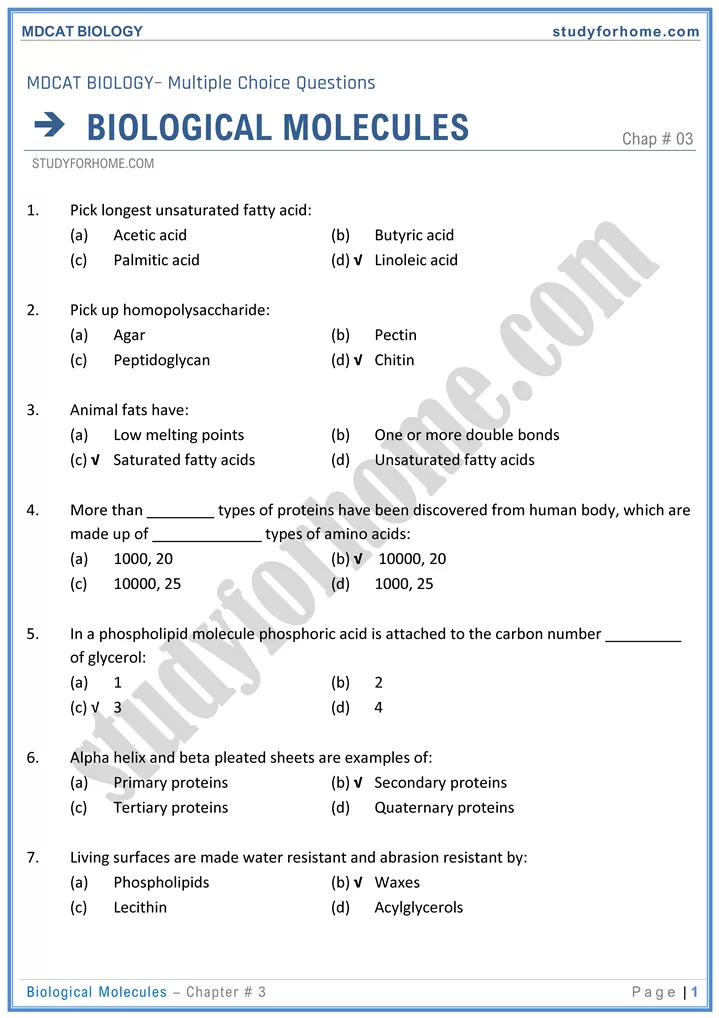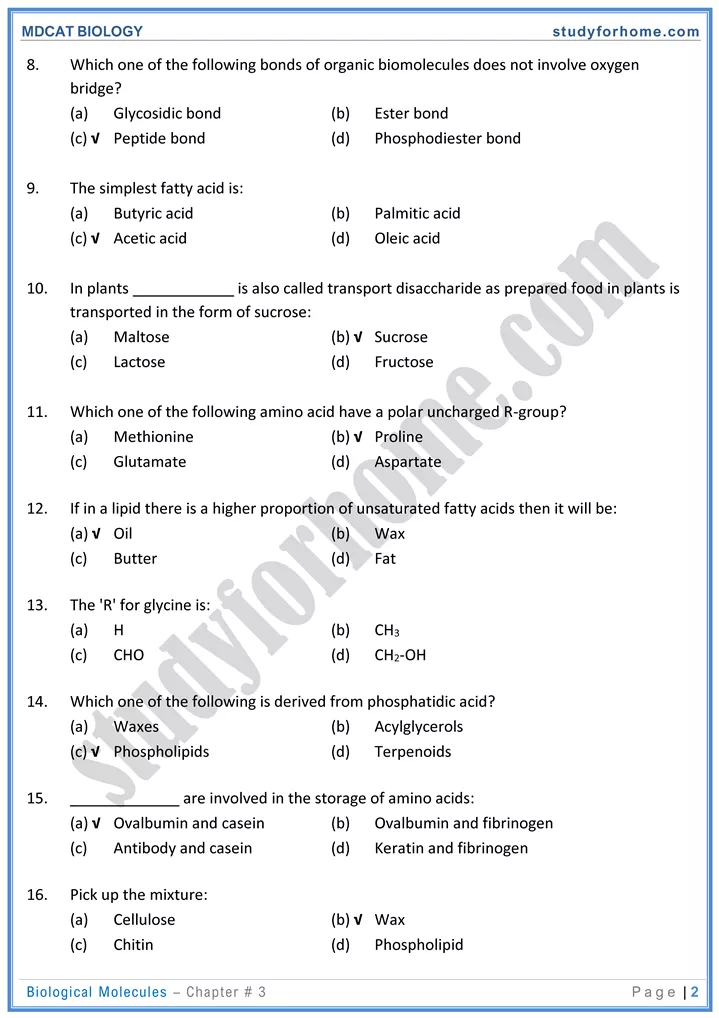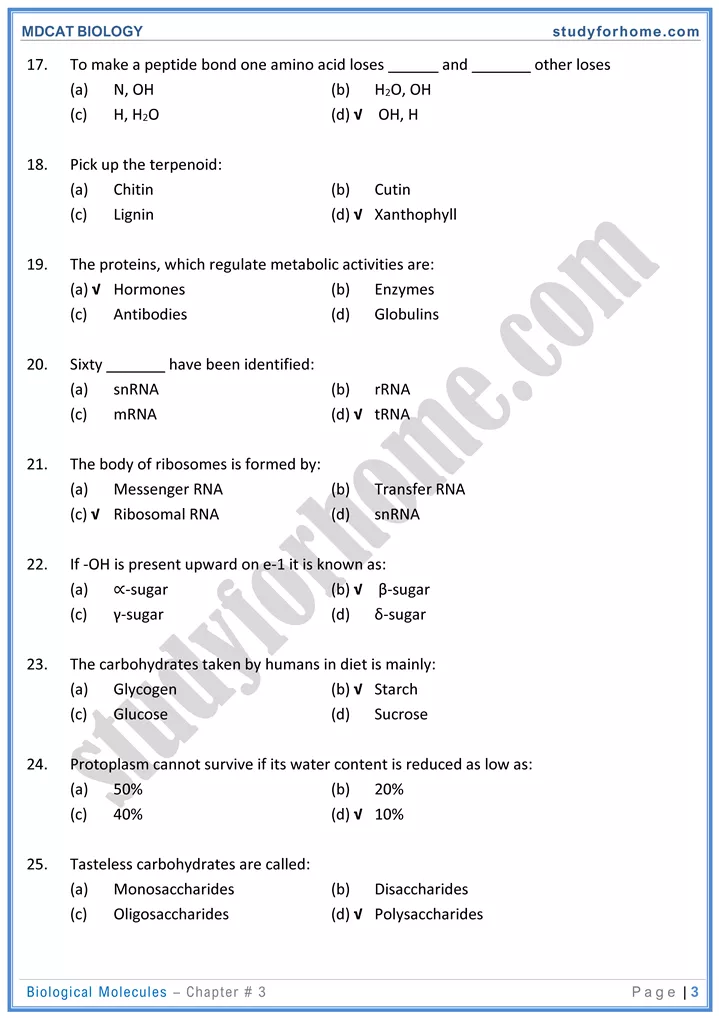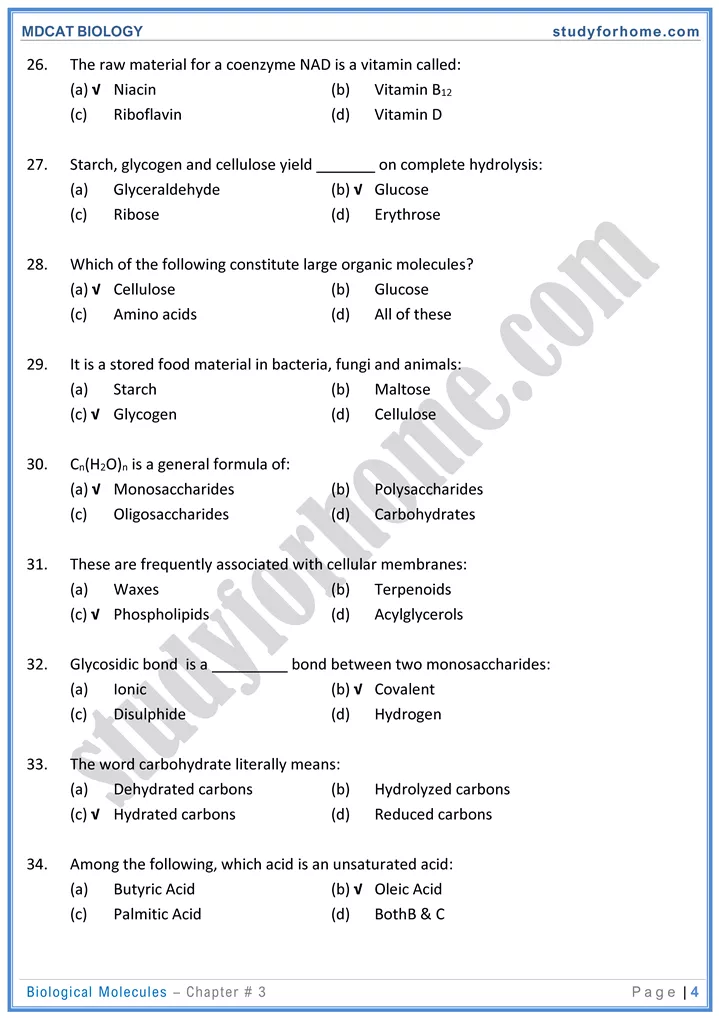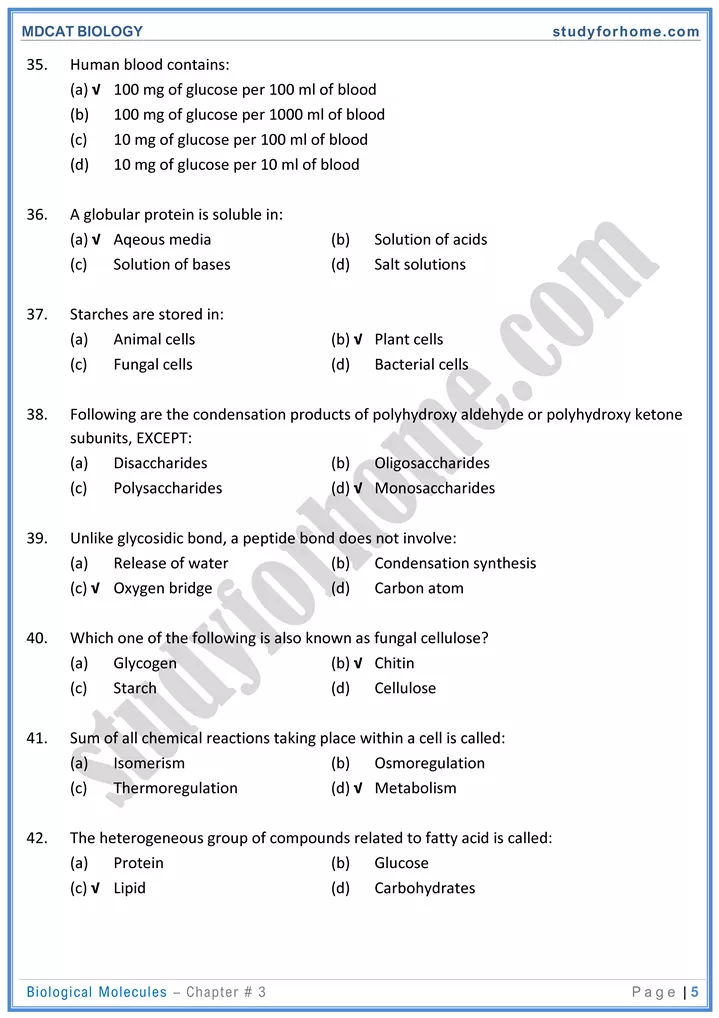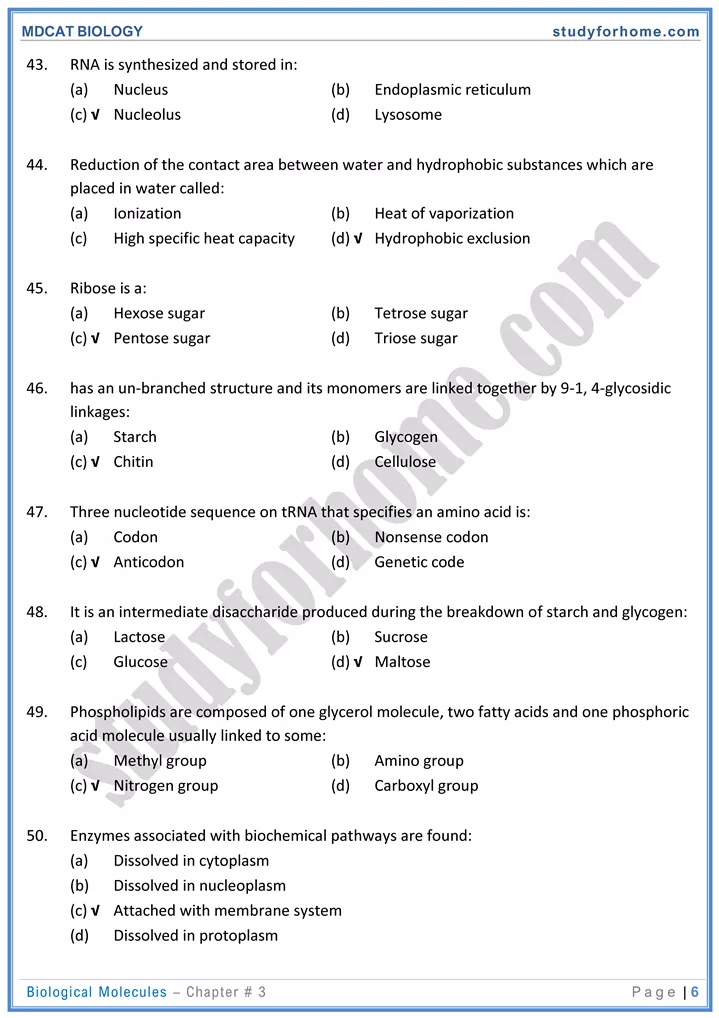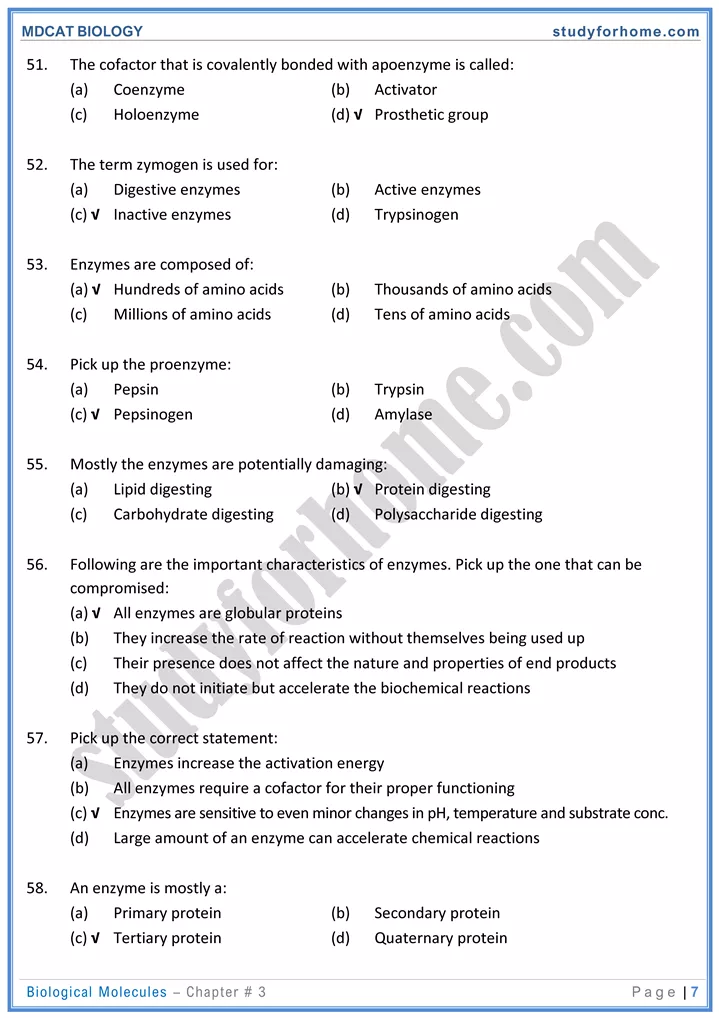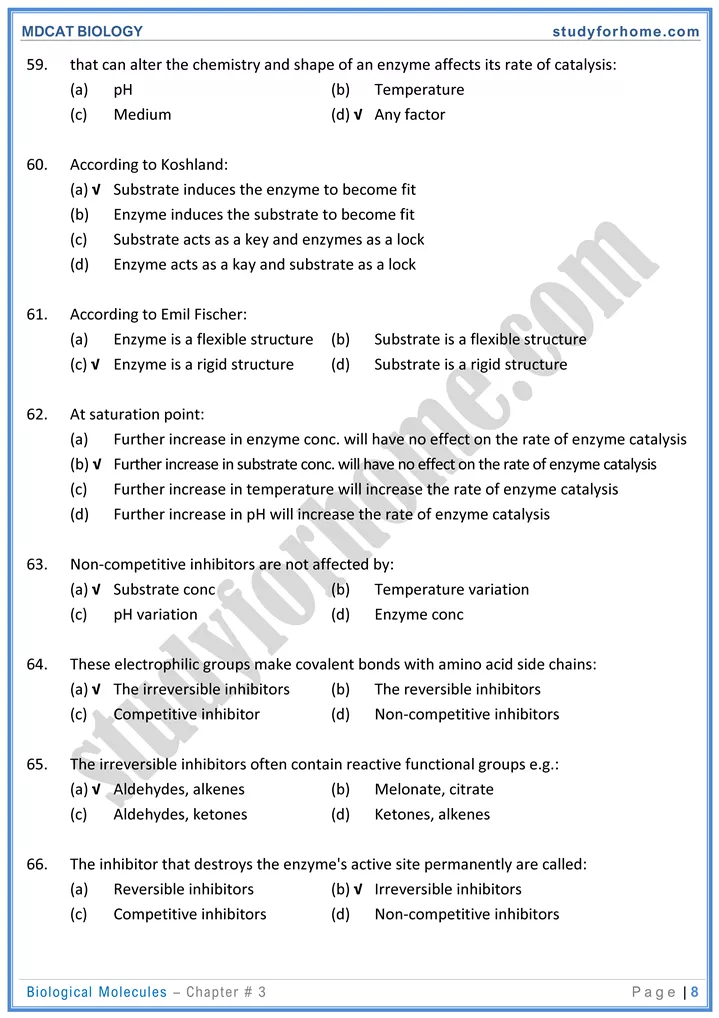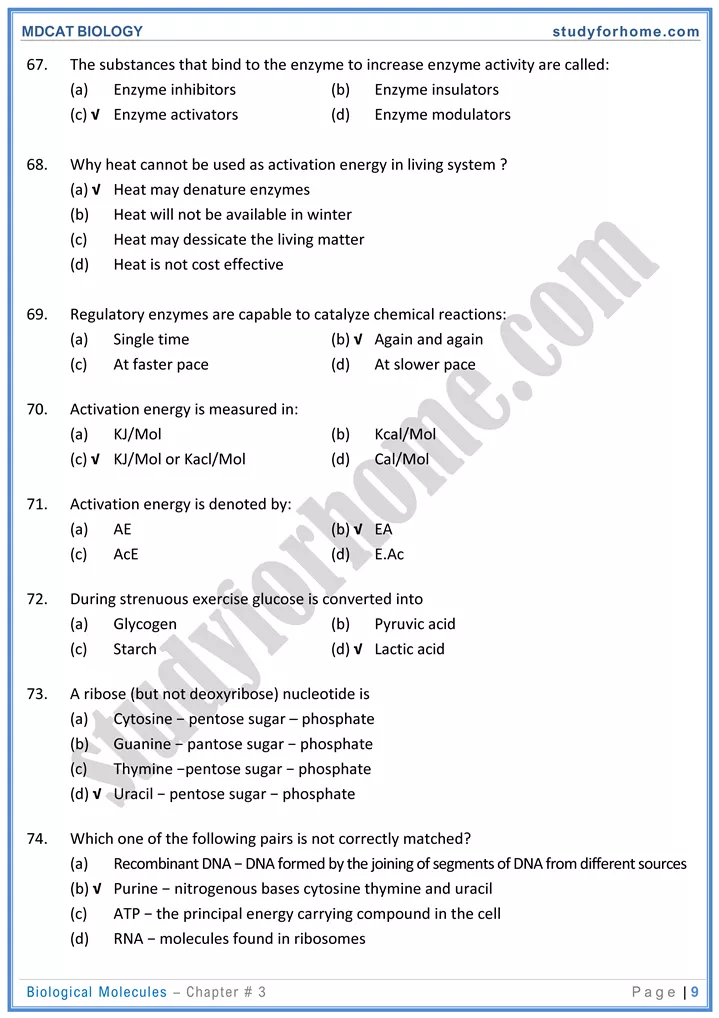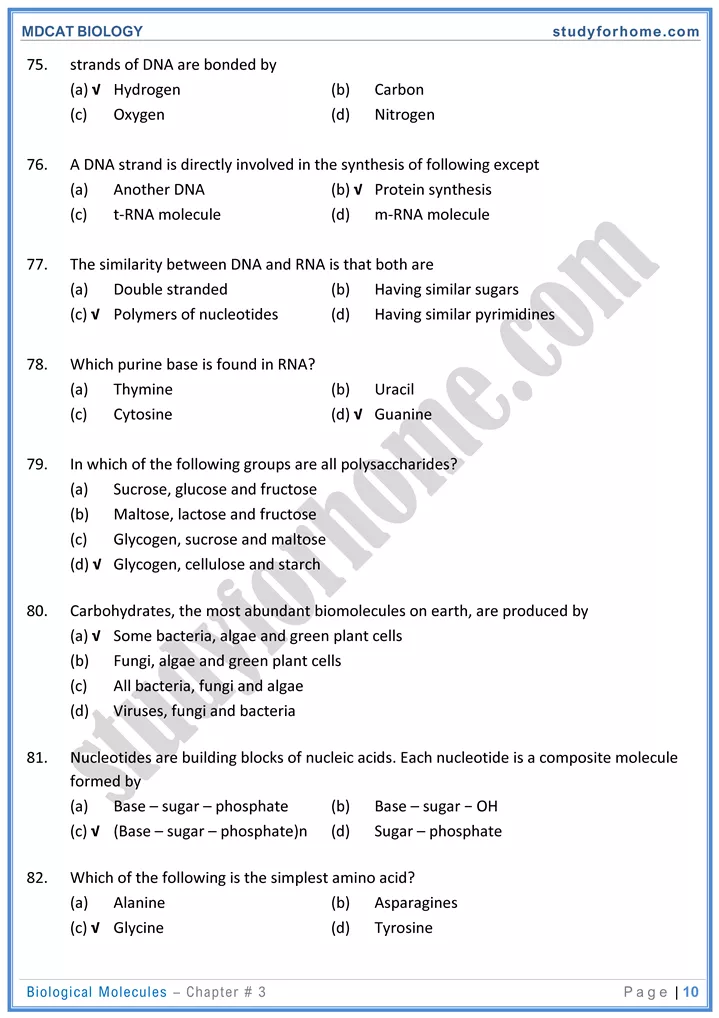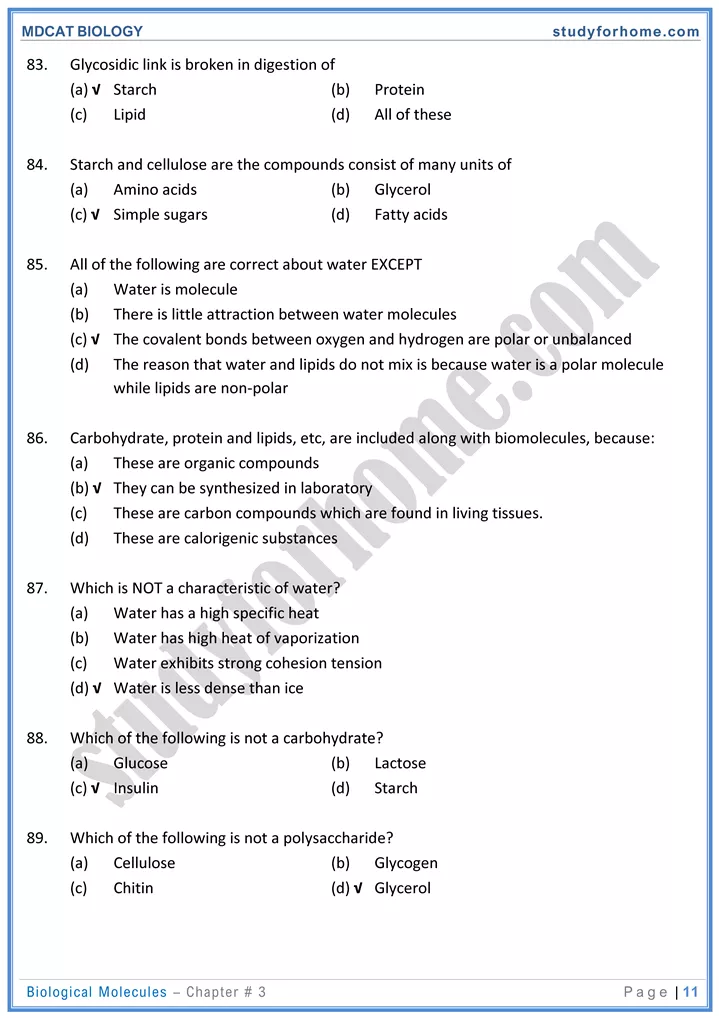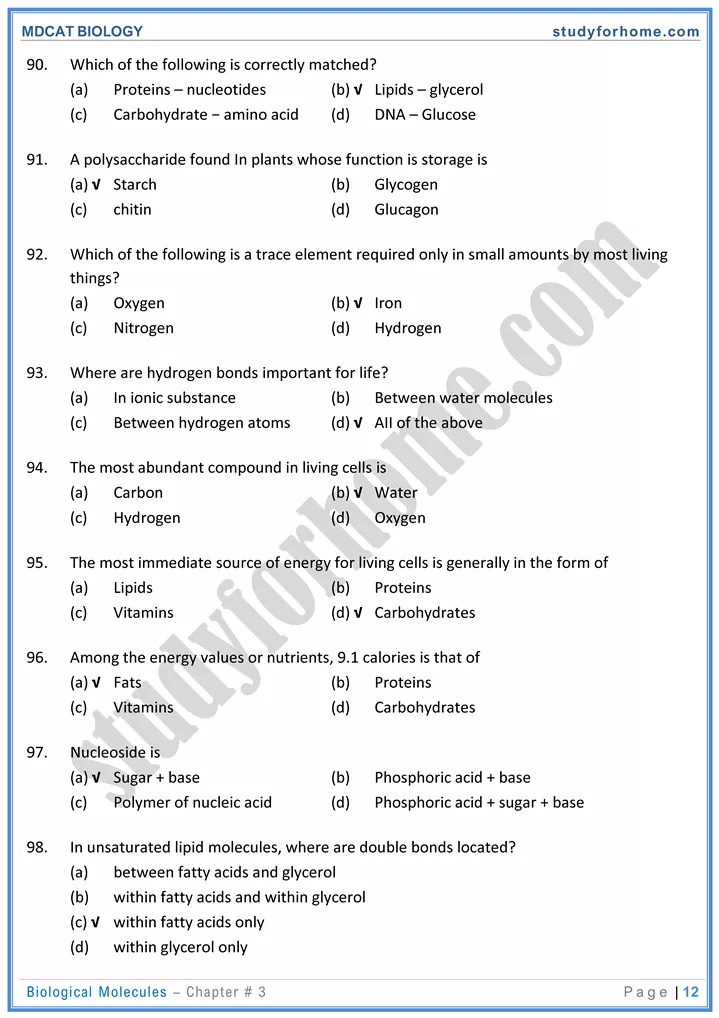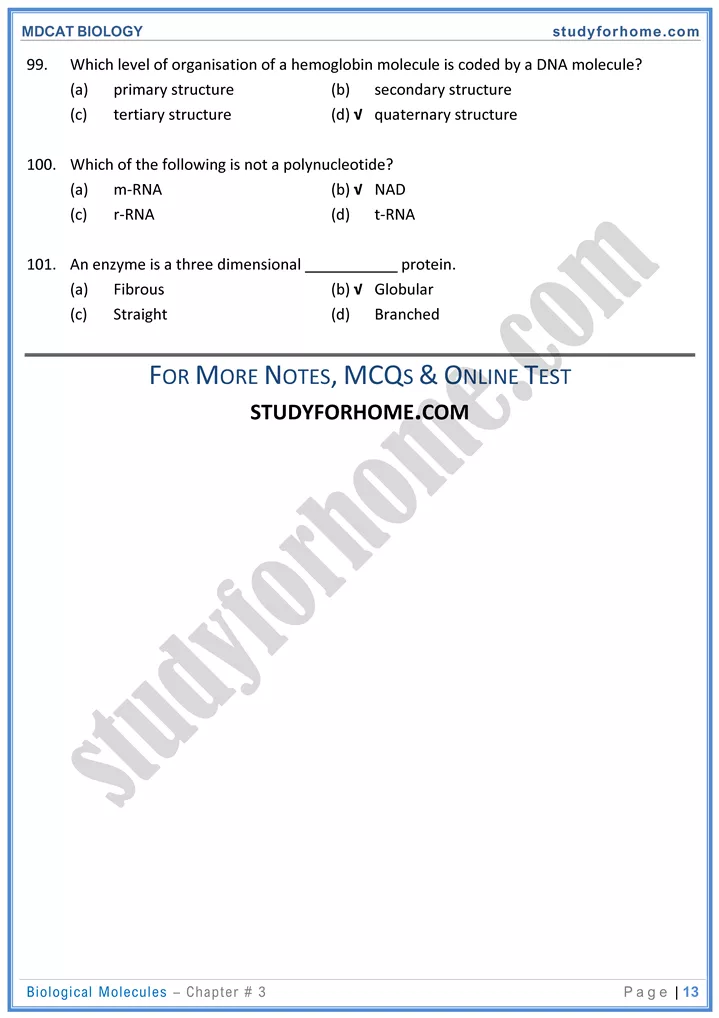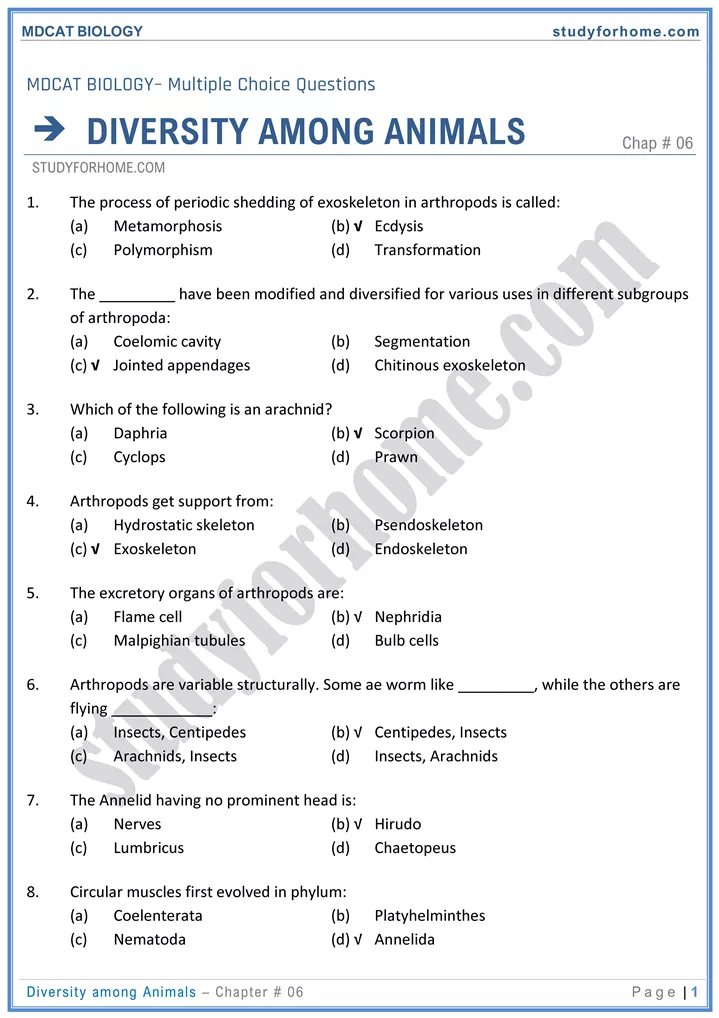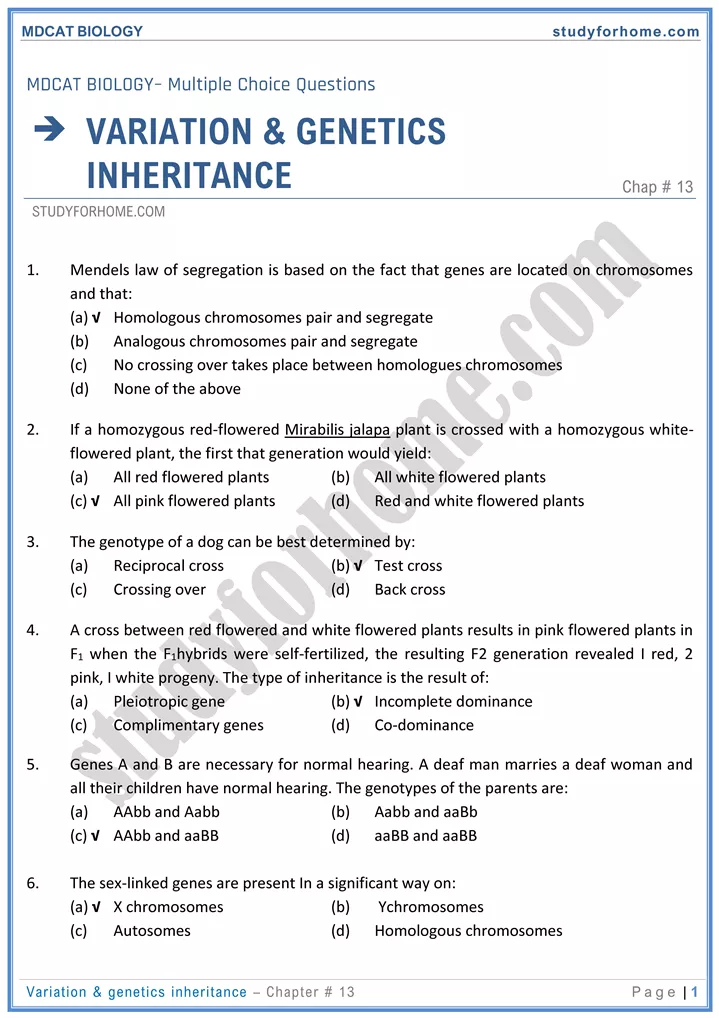MDCAT Biology – Chap#3 Biological Molecules
- Majority of biochemicals have C, H, O, N, P and S as a basic elements.
- The molecule containing both carbon and hydrogen in which carbon is bonded covalently to hydrogen atoms is called an organic molecule.
- Macromolecule is a very large molecule made up of smaller molecules linked together by covalent bonds.
- Proteins, carbohydrates (polysaccharides), lipids and nucleic acids are included in macromolecules.
- Polymers are long chain macromolecules consisting of repeating units (monomers) linked via covalent bonds.
- Monomers are linked through covalent bonding in a polymer. The covalent linkage in a macromolecule is named as under.
- Glycosidic bond (C − C): Covalent bond between two monosaccharides
- Peptide or Amide bond (C − N): Covalent bond between two amino acids.
- Ester bond (C − O); Covalent bond between carboxylic acid and alcohol in a lipid.
BIOLOGICALLY IMPORTANT PROPERTIES:
| Water | Carbon |
|---|---|
| Best solvent. High heat capacity High head of vaporization Amphotericity refers to good buffering activity Strong cohesive and adhesive properties | Can form four strong covalent bonds with other elements. Can form basic skeleton of variety of organic compounds. |
PROTEINS
- Most abundant compound in a cell is protein.
- Proteins are classified as
- Fibrous proteins: They are polypeptide chains in the form of fibrils. They constitute structural proteins in organisms. E.g. silk fiber, myosin, fibrin (of blood clot) Keratin (hair & nails).
- Globular proteins: They are folded polypeptide chains having tertiary structural level of proteins. The are soluble in water and constitute functional proteins in organisms. E.g. enzymes, antibodies, hormones and hemoglobin.
STRUCTURAL LEVELS OF PROTEINS:
- Primary structure: Refers to linear sequencing of amino acids in a polypeptide chain. E.g. Insulin.
- Secondary structure: Refers to coiling of a polypeptide chain in
-helix or
-pleated manner. E.g. Silk.
- Tertiary structure: Super coiling of a polypeptide chain in 3D form. E.g. Myoglobin.
- Quaternary structure: 3D shape of a protein consisting of two or more polypeptide chains, E.g. Hemoglobin.
BONDS PRESENT AT DIFFERENT LEVELS:
Peptide bond is present at all structural levels.
| Secondary | Tertiary | Quaternary |
|---|---|---|
| Peptide bond Hydrogen bond Sulphide bonds | Peptide bonds Ionic bonds Hydrogen bonds Disulphide bonds | Peptide bond Ionic bond Hydrogen bond Hydrophobic interaction |
DENATURATION:
- When unfolding of protein occurs it denatures. It could be reversible or irreversible
CARBOHYDRATES:
- Classified according to the number of unit sugars.
- Monosaccharides: single unit sugars, soluble in water and non hydrolysable. Categorized according to the number of carbon atoms, Starts from triose upto heptose having general formula (CH2O)n.
- Ribofuranose is a five cornered ring whereas glucopyranose is a six cornered ring.
- They could be aldehyde or ketone.
- Oligosaccharides: Contain 2 – 10 monosaccharide units. Disaccharide contains 2 units. Other intermediates from 3 – 10 units are known as dextrin. (c) Polysaccharides: polymer of monosaccharides (mainly hexose). Insoluble in aqueous medium. Storage polysaccharides. Include starch (in plants) and glycogen (In animals). Structural polysaccharide mainly include cellulose (plants), chitin (insects).
LIPIDS:
- Triglycerides / Acylglycerol / Fats and oils / Triacylglycerol.
- 1 Glycerol chain + 3 fatty acids.
- In oils, fatty acids are unsaturated i.e. having double bonds. Oils are mainly produced by plants e.g. Iinolein in cotton seeds.
- They contain twice the amount of energy as in carbohydrates .
- Fats are mainly produced by animals e.g. stearin in beef and mutton.
- Waxes:
- One fatty acid + a long chain alcohol. E.g. Bee’s wax CH3 (CH2)4COO(CH)29 CH3.
- Terpenoids: are terpenes like compounds consisting of repeating units called isoprenoid units(C5H8)
- (a) Terpenes: consists of only isoprenoid units. Many are volatile and have fragrance. They are used in synthesis of latex (rubber), Vitamin A, etc. present in many plant oils i.e. Menthol, rose, lemon etc.
- (b) Steroids: have common skeleton of steroid nucleus (4 rings; 3 with 6 – C and one with 5 – C). Remaining structure varies in different steroids. E.g. cholesterol, sex hormonestestosterone, progesterone, estrogens.
- (c) Carotenoids: are plant pigments which produce red, orange, yellow, etc, colors Consist of hydrocarbons with two 6 carbon rings one at each chain.
- Phospholipids:
- 1 glycerol + 2 fatty acids + 1 PO4 group.
- Constituent of cellular membranes, etc.
FUNCTIONS OF FEW BIOLOGICAL MOLECULES:
| Class | Functions |
|---|---|
| Water | Solvent, transport medium for dissolved materials and heat, cooling through evaporation. |
| Carbohydrates | Energy source; some structural role when attached to lipids or proteins; energy storage. |
| Lipids | Energy source; energy storage; insulations, structural components; chemical signaling; physical protection. |
| Proteins | Catalysts for metabolic reactions; structural components, movement; transport; buffers; defense; control and coordination of activities. |
| Nucleic acids | Storage and processing of information. |
NUCLEIC ACIDS: (Polynucleotides)
Nucleic acids are polymers of nucleotides. Nucleotides consist of a nitrogenous base, pentose sugar and a phosphate group. Nucleic acids can be denoted as (Base + sugar + phosphate)n.
- If a phosphate group is removed then it becomes nucleoside.
- Sugar component can be ribose or deoxyribose.
- Nitrogenous bases can be pyrimidines (single ringed) or purines (double ringed)
- Nucleosides are named as under
| RNA | DNA |
|---|---|
| Adenine + Ribose =Adenosine. | Adenine + deoxyribose = d-Adenosine. |
| Uracil + Ribose = Uridine. | Thymine + deoxyribose = d-Thymidine. |
| Guanine + Ribose = Guanosine. | Guanine + deoxyribose = d-Guanosine. |
| Cytosine + Ribose = Cytidine. | Cytosine + deoxyribose = d-Cytidine. |
- If we add a phosphate group to above nucleosides then it would called as a Nucleotide.
- AMP, d-AMP, ADP, d-ADP, etc are mononucleotides.
- Nicotine amide dinucleotide phosphate (NAD) is a dinucleotide.
- Ribonucleic Acids i.e. m-RNA, r-RNA, t-RNA and Deoxyribonucleic acid (DNA) are polynucleotides.
Note: Thymine is a nitrogenous base whereas thiamine is a vitamin.
- Cytosine is a nitrogenous base whereas Adenosine and guanosine are ribose sugar.
Conjugated Molecules:
1. Glycoproteins (Mucoids)
Carbohydrate + Proteins. e.g. egg albumin, cellular secretions (some hormones like gonadotrophic hormone. etc), component of cell membrane, etc.
2. Glycolipids / cerebrosides.
Lipids + carbohydrates + others.
e.g. component of brain tissue, sulpholipids of chloroplast, etc are examples of glycolipids.
3. Nucleoproteins:
Nucleic acids + proteins.
e.g. chromosomes i.e. DNA + histone proteins.
4. Lipoproteins:
Lipids + proteins.
Mainly lipids are lecithin / cholesterol They form all the cellular membranes of cell and organelles. They also act as transporter of lipids and fatly acids in blood. e.g. Myeline sheath, membranes of bacteria, LDL, etc.
5. Fibrons Protein:
Fibre or elongated in shape, H2O insoluble compounds. e.g. Action & myosin
6. Globular Protein:
Globules or spherical in shape, H2O soluble compounds e.g. lysozyme & other enzymes.
